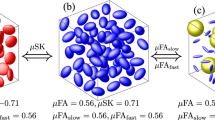Abstract
Brain tissue microarchitecture is characterized by heterogeneous degrees of diffusivity and rates of transverse relaxation. Unlike standard diffusion MRI with a single echo time (TE), which provides information primarily on diffusivity, relaxation-diffusion MRI involves multiple TEs and multiple diffusion-weighting strengths for probing tissue-specific coupling between relaxation and diffusivity. Here, we introduce a relaxation-diffusion model that characterizes tissue apparent relaxation coefficients for a spectrum of diffusion length scales and at the same time factors out the effects of intra-voxel orientation heterogeneity. We examined the model with an in vivo dataset, acquired using a clinical scanner, involving different health conditions. Experimental results indicate that our model caters to heterogeneous tissue microstructure and can distinguish fiber bundles with similar diffusivities but different relaxation rates. Code with sample data is available at https://github.com/dryewu/RDSI.
Y. Wu and X. Liu—Contributed equally to the paper.
This work was supported by the National Natural Science Foundation of China (No. 62201265, 61971214), and the Natural Science Foundation of Hubei Province of China (No. 2021CFB442). P.-T. Yap was supported in part by the United States National Institutes of Health (NIH) through grants MH125479 and EB008374.
Access this chapter
Tax calculation will be finalised at checkout
Purchases are for personal use only
Similar content being viewed by others
References
Anania, V., et al.: Improved diffusion parameter estimation by incorporating T2 relaxation properties into the DKI-FWE model. Neuroimage 256, 119219 (2022)
Assaf, Y., Freidlin, R.Z., Rohde, G.K., Basser, P.J.: New modeling and experimental framework to characterize hindered and restricted water diffusion in brain white matter. Magn. Reson. Med. 52(5), 965–978 (2004)
Barakovic, M., et al.: Bundle-specific axon diameter index as a new contrast to differentiate white matter tracts. Front. Neurosci. 15, 646034 (2021)
Cowan, B., Cowan, B.P.: Nuclear Magnetic Resonance and Relaxation, vol. 427. Cambridge University Press, Cambridge (1997)
Ellingson, B.M., Wen, P.Y., Cloughesy, T.F.: Modified criteria for radiographic response assessment in glioblastoma clinical trials. Neurotherapeutics 14(2), 307–320 (2017)
Gong, T., Tong, Q., He, H., Sun, Y., Zhong, J., Zhang, H.: MTE-NODDI: multi-TE NODDI for disentangling non-T2-weighted signal fractions from compartment-specific T2 relaxation times. Neuroimage 217, 116906 (2020)
Hu, L.S., Hawkins-Daarud, A., Wang, L., Li, J., Swanson, K.R.: Imaging of intratumoral heterogeneity in high-grade glioma. Cancer Lett. 477, 97–106 (2020)
Huynh, K.M., et al.: Probing tissue microarchitecture of the baby brain via spherical mean spectrum imaging. IEEE Trans. Med. Imaging 39(11), 3607–3618 (2020)
Jeurissen, B., Tournier, J.D., Dhollander, T., Connelly, A., Sijbers, J.: Multi-tissue constrained spherical deconvolution for improved analysis of multi-shell diffusion MRI data. Neuroimage 103, 411–426 (2014)
Kaden, E., Kelm, N.D., Carson, R.P., Does, M.D., Alexander, D.C.: Multi-compartment microscopic diffusion imaging. Neuroimage 139, 346–359 (2016)
Lampinen, B., et al.: Towards unconstrained compartment modeling in white matter using diffusion-relaxation MRI with tensor-valued diffusion encoding. Magn. Reson. Med. 84(3), 1605–1623 (2020)
Li, Y., Srinivasan, R., Ratiney, H., Lu, Y., Chang, S.M., Nelson, S.J.: Comparison of T1 and T2 metabolite relaxation times in glioma and normal brain at 3T. J. Magn. Reson. Imaging 28(2), 342–350 (2008). https://onlinelibrary.wiley.com/doi/pdf/10.1002/jmri.21453
McDonald, E.S., et al.: Mean apparent diffusion coefficient is a sufficient conventional diffusion-weighted MRI metric to improve breast MRI diagnostic performance: results from the ECOG-ACRIN cancer research group A6702 diffusion imaging trial. Radiology 298(1), 60 (2021)
McKinnon, E.T., Jensen, J.H.: Measuring intra-axonal T\(_{\rm 2 }\) in white matter with direction-averaged diffusion MRI. Magn. Reson. Med. 81(5), 2985–2994 (2019)
Morozov, S., et al.: Diffusion processes modeling in magnetic resonance imaging. Insights Imaging 11(1), 60 (2020)
Ning, L., Gagoski, B., Szczepankiewicz, F., Westin, C.F., Rathi, Y.: Joint relaxation-diffusion imaging moments to probe neurite microstructure. IEEE Trans. Med. Imaging 39(3), 668–677 (2020)
Ning, L., Westin, C.F., Rathi, Y.: Characterization of b-value dependent T2 relaxation rates for probing neurite microstructure. bioRxiv. Cold Spring Harbor Laboratory (2022)
Palombo, M., et al.: SANDI: a compartment-based model for non-invasive apparent soma and neurite imaging by diffusion MRI. Neuroimage 215, 116835 (2020)
Pizzolato, M., Andersson, M., Canales-Rodríguez, E.J., Thiran, J.P., Dyrby, T.B.: Axonal T2 estimation using the spherical variance of the strongly diffusion-weighted MRI signal. Magn. Reson. Imaging 86, 118–134 (2022)
Reymbaut, A.: Diffusion anisotropy and tensor-valued encoding. In: Topgaard, D. (ed.) New Developments in NMR, pp. 68–102. Royal Society of Chemistry, Cambridge (2020)
Slator, P.J., et al.: Combined diffusion-relaxometry microstructure imaging: Current status and future prospects. Magn. Reson. Med. 86(6), 2987–3011 (2021)
Sotardi, S., et al.: Voxelwise and regional brain apparent diffusion coefficient changes on MRI from birth to 6 years of age. Radiology 298(2), 415 (2021)
Tavakoli, M.B., Khorasani, A., Jalilian, M.: Improvement grading brain glioma using T2 relaxation times and susceptibility-weighted images in MRI. Inform. Med. Unlocked 37, 101201 (2023)
Upadhyay, N., Waldman, A.: Conventional MRI evaluation of gliomas. Br. J. Radiol. 84(2), S107–S111 (2011)
Veraart, J., Novikov, D.S., Fieremans, E.: TE dependent Diffusion Imaging (TEdDI) distinguishes between compartmental T2 relaxation times. Neuroimage 182, 360–369 (2018)
Veraart, J., et al.: Noninvasive quantification of axon radii using diffusion MRI. eLife 9, e49855 (2020)
Weisskoff, R., Zuo, C.S., Boxerman, J.L., Rosen, B.R.: Microscopic susceptibility variation and transverse relaxation: theory and experiment. Magn. Reson. Med. 31(6), 601–610 (1994)
White, N.S., Leergaard, T.B., D’Arceuil, H., Bjaalie, J.G., Dale, A.M.: Probing tissue microstructure with restriction spectrum imaging: histological and theoretical validation. Hum. Brain Mapp. 34(2), 327–346 (2013)
Zhang, H., Schneider, T., Wheeler-Kingshott, C.A., Alexander, D.C.: NODDI: practical in vivo neurite orientation dispersion and density imaging of the human brain. Neuroimage 61(4), 1000–1016 (2012)
Author information
Authors and Affiliations
Corresponding authors
Editor information
Editors and Affiliations
Rights and permissions
Copyright information
© 2023 The Author(s), under exclusive license to Springer Nature Switzerland AG
About this paper
Cite this paper
Wu, Y., Liu, X., Zhang, X., Huynh, K.M., Ahmad, S., Yap, PT. (2023). Relaxation-Diffusion Spectrum Imaging for Probing Tissue Microarchitecture. In: Greenspan, H., et al. Medical Image Computing and Computer Assisted Intervention – MICCAI 2023. MICCAI 2023. Lecture Notes in Computer Science, vol 14227. Springer, Cham. https://doi.org/10.1007/978-3-031-43993-3_15
Download citation
DOI: https://doi.org/10.1007/978-3-031-43993-3_15
Published:
Publisher Name: Springer, Cham
Print ISBN: 978-3-031-43992-6
Online ISBN: 978-3-031-43993-3
eBook Packages: Computer ScienceComputer Science (R0)





